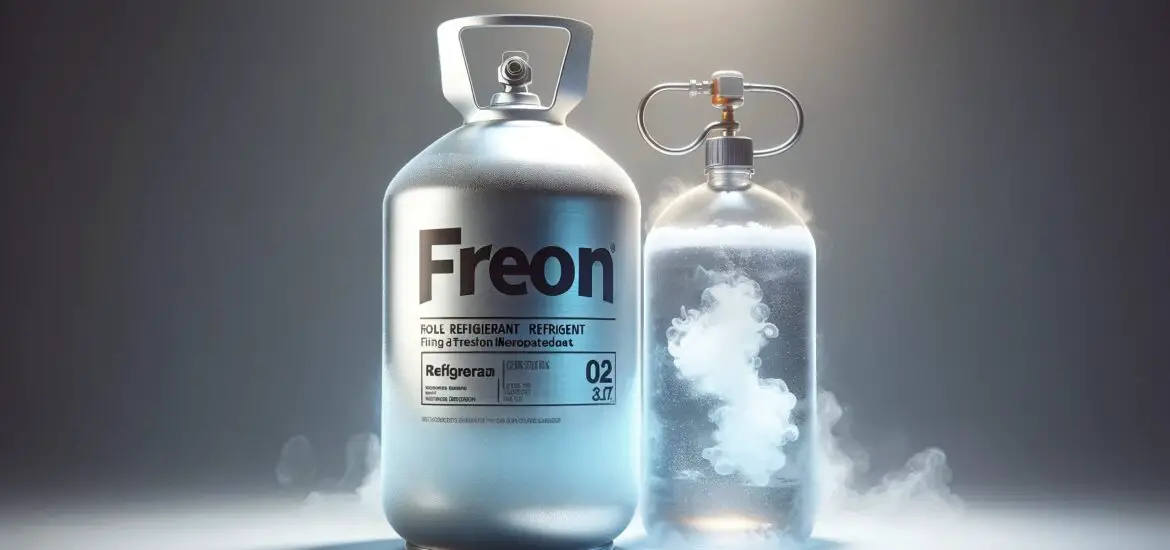This guide aims to reveal the differences between Freon vs liquid nitrogen, ensuring you have all the information needed to make an informed decision.

Table of Contents
Understanding Freon
Freon, a trade name for a class of chlorofluorocarbons and hydrochlorofluorocarbons, has been a cornerstone in refrigeration and air conditioning systems for decades. These compounds are characterized by their stability, non-flammability, and relative non-toxicity, making them popular in a variety of cooling applications.
However, their stability becomes a detriment to the ozone layer. These compounds when released into the atmosphere, contribute significantly to ozone depletion.
Different types of Freon have been used over the years, with R-12, R-22, and R-134a being among the most common. Each type has distinct properties and applications, with varying degrees of environmental impact.
R-12 was one of the first to be phased out due to its high ozone-depleting potential. Subsequent versions like R-134a were developed to reduce this impact, but concerns remain about their global warming potential.
Despite its historical importance, the use of Freon is diminishing under international environmental agreements like the Montreal Protocol. This treaty, aimed at protecting the ozone layer, has led to the development and adoption of alternative refrigerants with lower environmental risks. As a result, the refrigeration and air conditioning industries are transitioning towards more sustainable solutions.
Exploring Liquid Nitrogen
Liquid nitrogen is a colorless, odorless, non-toxic, and inert liquid at extremely low temperatures (-196°C or -320°F). As a cryogenic fluid, it can rapidly freeze substances, a property exploited in various industrial, medical, and culinary applications. Its ability to maintain extremely low temperatures efficiently makes it an invaluable tool in areas where precise temperature control is crucial.
In the medical field, liquid nitrogen is used for cryopreservation (freezing and storing cells, tissues, or organs at cryogenic temperatures) and cryosurgery (destroying diseased tissue). In the food industry, it’s used for rapid freezing to preserve freshness and texture. Its use in culinary arts for creating unique dishes and textures has also gained popularity.
Moreover, liquid nitrogen is employed in various scientific research and industrial applications. This includes the cooling of materials to study their properties at low temperatures or in electronics where it’s used to cool superconducting materials.
It’s also utilized in transporting temperature-sensitive goods, showcasing its versatility beyond traditional freezing applications.
Freon vs Liquid Nitrogen
Now that we’ve gotten a good picture of what these two substances are, let’s compare them side by side on two key aspects.
Comparison of Uses
While Freon is primarily used in commercial and residential air conditioning and refrigeration systems, liquid nitrogen’s applications span a wider range of fields due to its extreme cooling capabilities.
Freon’s role in air conditioning systems involves a cycle of compression and expansion. It absorbs heat from the environment and releases it elsewhere, thus cooling indoor spaces or refrigerated compartments.
Liquid nitrogen, with its rapid freezing ability, is not suitable for such gradual cooling processes. Instead, it finds use in applications that require instant freezing or maintaining materials at very low temperatures. This includes specialized medical procedures, scientific research, and certain industrial processes where quick and extreme cooling is necessary.
The fundamental difference in their cooling mechanisms—Freon through a refrigeration cycle and liquid nitrogen through direct contact cooling—dictates their respective applications. Freon is more suited for sustained, moderate cooling, while liquid nitrogen excels in short-duration, intensive cooling scenarios.
Safety and Environmental Impact
The environmental and safety considerations for Freon and liquid nitrogen are markedly different. Freon, particularly older types, poses a significant threat to the ozone layer, contributing to its depletion. This has led to regulatory measures to phase out the most harmful types.
In terms of safety, Freon can cause health issues if inhaled in large quantities, leading to symptoms like dizziness, headache, and in extreme cases, asphyxiation.
Liquid nitrogen, while environmentally benign, presents unique safety challenges. Its extremely low temperature can cause severe frostbite upon contact with skin or damage to materials not designed to withstand such temperatures.
In addition, in enclosed spaces, the evaporation of liquid nitrogen can displace oxygen, creating an asphyxiation hazard. Proper ventilation and protective gear are essential when handling liquid nitrogen.
Both substances require careful handling, appropriate storage, and adherence to safety guidelines to minimize risks to users and the environment. While Freon’s impact is more on the global environmental scale, liquid nitrogen’s risks are more immediate and localized, necessitating different safety protocols.